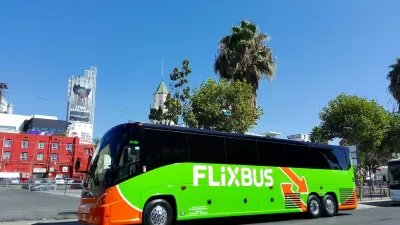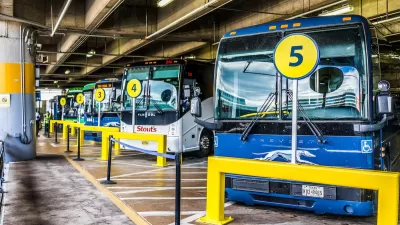Riders on the ‘forgotten stepchild’ of the U.S. transportation system find themselves waiting for buses curbside as Greyhound sells off its real estate in many U.S. cities.

“More people are taking long-distance bus trips than at any time since the start of the pandemic. Unfortunately, they have fewer places where they can get on and off.” Jared Brey outlines the issue in Governing, writing that intercity bus service has recovered by 85 to 90 percent since the pandemic, according to the Chaddick Institute for Metropolitan Development at DePaul University.
However, Greyhound closed multiple major stations around the country last year, forcing passengers to wait for buses on public sidewalks with no services or amenities. In Philadelphia, the closure of a downtown bus terminal “was seen locally as a disaster, with riders waiting for long stretches on the sidewalk with no shelter or restrooms — and sometimes having a hard time finding information about where and when the bus was coming. The buses also idled in a lane that was meant to be dedicated to local transit.” The closure of terminals not only makes travel more unsafe and inconvenient for riders, but also impedes other traffic and makes it more difficult to link inter-operator trips.
Brey notes that “Some states are having success with state-run intercity bus services, including Virginia Breeze and Bustang in Colorado, both of which saw big increases in ridership in 2023.” Additionally, “The Infrastructure Investment and Jobs Act also provides fundings that cities and states could use to invest in transportation terminals.”
Joseph Schwieterman, director of the Chaddick Institute, says he expects more collaboration between Amtrak and intercity bus lines in the near future.
FULL STORY: More Riders, Fewer Stations for Intercity Bus Lines

Study: Maui’s Plan to Convert Vacation Rentals to Long-Term Housing Could Cause Nearly $1 Billion Economic Loss
The plan would reduce visitor accommodation by 25,% resulting in 1,900 jobs lost.

North Texas Transit Leaders Tout Benefits of TOD for Growing Region
At a summit focused on transit-oriented development, policymakers discussed how North Texas’ expanded light rail system can serve as a tool for economic growth.

Why Should We Subsidize Public Transportation?
Many public transit agencies face financial stress due to rising costs, declining fare revenue, and declining subsidies. Transit advocates must provide a strong business case for increasing public transit funding.

How to Make US Trains Faster
Changes to boarding platforms and a switch to electric trains could improve U.S. passenger rail service without the added cost of high-speed rail.

Columbia’s Revitalized ‘Loop’ Is a Hub for Local Entrepreneurs
A focus on small businesses is helping a commercial corridor in Columbia, Missouri thrive.

Invasive Insect Threatens Minnesota’s Ash Forests
The Emerald Ash Borer is a rapidly spreading invasive pest threatening Minnesota’s ash trees, and homeowners are encouraged to plant diverse replacement species, avoid moving ash firewood, and monitor for signs of infestation.
Urban Design for Planners 1: Software Tools
This six-course series explores essential urban design concepts using open source software and equips planners with the tools they need to participate fully in the urban design process.
Planning for Universal Design
Learn the tools for implementing Universal Design in planning regulations.
City of Santa Clarita
Ascent Environmental
Institute for Housing and Urban Development Studies (IHS)
City of Grandview
Harvard GSD Executive Education
Toledo-Lucas County Plan Commissions
Salt Lake City
NYU Wagner Graduate School of Public Service





























